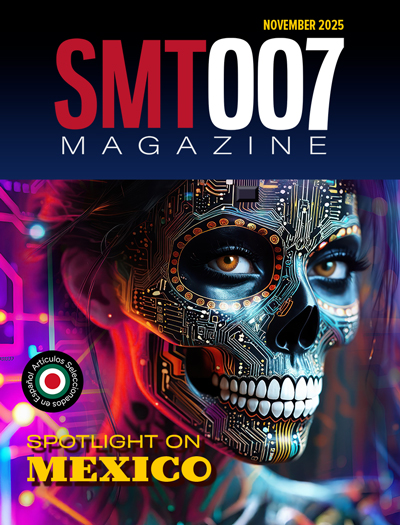-

- News
- Books
Featured Books
- smt007 Magazine
Latest Issues
Current Issue
Spotlight on Mexico
Mexico isn’t just part of the electronics manufacturing conversation—it’s leading it. From growing investments to cross-border collaborations, Mexico is fast becoming the center of electronics in North America. This issue includes bilingual content, with all feature articles available in both English and Spanish.

Production Software Integration
EMS companies need advanced software systems to thrive and compete. But these systems require significant effort to integrate and deploy. What is the reality, and how can we make it easier for everyone?

Spotlight on India
We invite you on a virtual tour of India’s thriving ecosystem, guided by the Global Electronics Association’s India office staff, who share their insights into the region’s growth and opportunities.
- Articles
Article Highlights
- Columns
- Links
- Media kit
||| MENU - smt007 Magazine
Estimated reading time: 5 minutes
Contact Columnist Form
Standing Room Only at ICT's Winsford, UK Seminar
In cooperation with Merlin Circuit Technology, deep eutectic solvent formulations had been evaluated as hot-air solder levelling fluxes with remarkable success. Copper was wetted more rapidly than with proprietary HASL fluxes and complete coverage was achieved in a single dip. One very interesting outcome was the ability to solder-level with lead-free solder on PCBs with electroless nickel finish, not previously achievable with conventional fluxes, and this opened up the prospect of a novel solderable finish dubbed Hot Air Solder Levelling on Electroless Nickel (HASLEN).
ICT Chairman Professor Martin Goosey gave the third presentation, entitled Recovery of Copper from PCB Manufacturing Processes using Crab Shells, describing the TSB-funded STOWURC project whose objective was to develop sustainable materials and processes using waste products from the seafood industry to treat effluent and recover metals from PCB manufacture.
The whole supply chain, from raw material to dissemination of information, was represented in the project consortium. It had been observed that a natural component of the shells of crustaceans, chitin, was able to adsorb heavy metals from dilute solution, and that a simple chemical modification of chitin, by alkaline deacetylation to form chitosan, significantly improved the efficiency of adsorption. For example, one gram of chitosan was capable of adsorbing 250 milligrams of copper.
Professor Goosey summarised the results of initial experiments. The effects on adsorption rates of parameters such as temperature, pH, initial concentration, rate of mixing, specific metal ions had been studied, over a range of chitosan parameters including the amount of adsorbant, the degree of deacetylation and the particle size. It was possible to reduce copper concentration in effluent to the 0.1 ppm level.
Having captured the metal, it was possible to desorb it with sulphuric acid and recover it by straightforward electroplating. A key issue was the residual adsorption efficiency of the chitosan after stripping of copper; there was a tendency for absorption ability to decrease with each cycle, and conditions were being optimised to minimise the effect.
Chitosan had the ability to adsorb a wide range of metals found in PCB effluent, nickel for example, and there were many applications in the general metal finishing industry. It also provided the opportunity to recover endangered or rare metals from low concentration solutions. Professor Goosey mentioned platinum, palladium, rhodium, osmium, iridium, mercury, and gold as examples, but made it clear that each metal would need an optimised combination of process parameters and conditions.
Page 2 of 3
More Columns from The European Angle
CircuitData: A New Open Standard for PCB Fab Data ExchangeI Never Realised It Was So Complicated!
The European Angle: Institute of Circuit Technology 43rd Annual Symposium
Ventec International Group's Martin Cotton Celebrates 50 Years in PCB Design
Reporting on the Institute of Circuit Technology Spring Seminar
EuroTech: Raw Materials Supply Chain—Critical Challenges Facing the PCB Industry
EuroTech: ENIPIG—Next Generation of PCB Surface Finish
EuroTech: Institute of Circuit Technology Northern Seminar 2016, Harrogate


